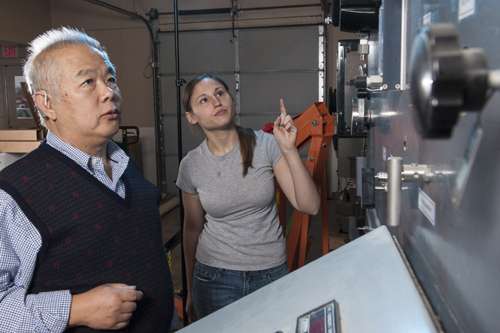Can engineers develop a more flexible, eco-friendly plastic for packaging?

(Phys.org) —The idea of '"going green" for one person can mean anything from driving a hybrid car to simply recycling glass bottles. But Barbi Wheelden, a doctoral student in chemical engineering, is thinking more globally. She's seeking a way for manufacturers to use a more eco-friendly and biodegradable plastic in their packaging.
Wheelden is using a component called polylactide, a bio-based plastic that comes from any crop with a starch, such as corn or sugar. However, polylactide (also known as PLA) itself is too brittle, making it necessary to blend a more flexible polymer or other plasticizing additive with it in order to use it for flexible packaging. She's researching how to come up with a bio-based, eco-friendly plasticizer so that PLA can be used for an even broader range of applications.
"My goal is to create a more flexible, tougher polylactide blend," she says.
Currently, Wheelden explains, it's more expensive to make bio-based plastics than synthetic plastics like polyethylene. She and her advisor, Sunggyu Lee, professor of chemical and biomolecular engineering, hope that their work could make bio-based plastics a more viable alternative.
"By creating polymers from bio-based resources, they would come from a renewable source and would decrease dependence on petroleum-based products," Lee says. "The biodegradability of packaging materials would be greatly beneficial so they could be fully composted rather than taking up space in landfills."
So far Wheelden, who is working with natural rubber, has studied two different blends and has made numerous presentations on her research, including at the American Institute of Chemical Engineers annual conference. She traveled to Korea last summer to complete a research internship.
In Athens, she conducts her research at Lee's Sustainable Energy and Advanced Materials Laboratory, where she uses newly acquired equipment to make samples and test various properties of them. She's known Lee since her undergraduate days at the Missouri University of Science and Technology. During her senior year, she decided to follow him to Ohio University for graduate research and now is in the midst of her third year.
In addition to her research in the lab, she gives tours to visitors, works with undergraduates, researches different companies that supply analytical or processing equipment, and takes care of any necessary lab maintenance.
The lab is involved in not only bioplastics work, but pursues other chemical engineering research such as developing alternative fuel technologies, improving conventional fossil fuel utilization technology, and chlorine dioxide technology, which is a more environmentally and health-friendly water purification option than many existing technologies.
After Wheelden graduates in 2014 or 2015, she may consider either working in a national laboratory or teaching, as she enjoys interacting with people. Regardless of her career path, Wheelden remains confident that she has a wide array of valuable skills to offer.
"Whatever I end up doing," she says, "I'll try my best and hopefully bring something to the table."
Provided by Ohio University
















